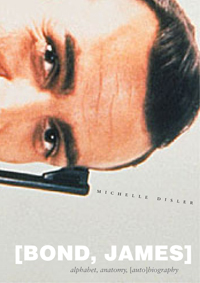 [BOND, JAMES]: alphabet, anatomy, [auto]biography
[BOND, JAMES]: alphabet, anatomy, [auto]biography
by Michelle Disler
Counterpath Press, 2011
120 pages / $14.95 Buy from Counterpath, Amazon or SPD
Superficially [Bond, James] is an exploration of the Bond character as he appears in Ian Fleming’s novels: rescuing girls, thwarting villains, escaping from dangerous situations, and smoking a ton of cigarettes. What’s fascinating and brilliant and great about the book, though, is that we get this exploration and some rumination on the masculinity it represents not in standard linear nonfiction prose but as a series of lists and games and experiments. This makes the book worth your entertainment dollar in a variety of ways: as an investigation of a popular icon/fictional character, as a look at what represented the summit of masculinity 1953-1965 and how the ideal is shored up through the use of women (and villains) as disposable props, and as a really stunning example of how brilliant innovative nonfiction can be when it’s not afraid to take a lot of risks.
And the book does take risks. Divided into the three sections of the subtitle, the text never offers a moment of scholarly distance but instead offers you a spread of cross-sections of Bond as character and as archetype. In the first section, alphabet, you get just that: an alphabet comprised mostly of lists of common people, objects and events in Bond’s world. For example D is for “Dislikes” and you get a two-page inventory of things like the following:
These inventories pile up in the first half of the book and its the accumulation of details and broad categories that provides a portrait of Bond in a form as constricted and repetitive as Fleming’s novels but a lot more fun. Disler does quote from Fleming’s works, but only sparingly, and rarely enters the book herself except in O for “Objections,” for example, where she begins to raise her objections to Bond and demand explanations from him. That kind of play with setting rules and then bending them his handled expertly by Disler: the inventories never get dull, the forms never seem arbitrary, and the lack of narrative frame never feels bothersome. Instead, in the first half of the book, you get a Bond built out of constituent parts, one that leaves you with an ambiguous portrait of a supposedly generic pulp novel hero.
In anatomy, that portrait gets refined by a wider variety of forms but a more narrow range of subject. As the section title indicates, the book gives you the layout of what James Bond is made of, and while Disler does this in alphabet, certain figures and themes are constantly revisited, including within sections, as in “Cigarettes [Bond, James]”, which gives you eleven pages of repetitions, variations and elaborations of the simple sentence “James Bond lit a cigarette.” This sentence appears on the page in list form 25 times, with no commentary other than a footnote explaining that cigarette-lighting is a common act in the Fleming novels. The sentence slowly gets increasingly elaborate, though, until you have baroque variations like such:
“Cigarettes” also introduces the main parts of James Bond’s anatomy, the things against which he can define himself: girls and villains. Girls and villains are a constant in anatomy, and probably a constant in the novels, and Disler makes it plain that girls were all but interchangeable, and so were villains, but how she plays with the stereotyping and the gender structure beneath it (girls being sex embodied and villains being de facto asexual) is what’s so great. Because while it would still be a great read to get a scholarly feminist analysis of the role of women in the Fleming novels, Disler is more interested in toying around with formal conventions so that you get a cavalcade of girls and villains for Bond to encounter. Girls and Villains are constants, revisited through a series of uniquely formatted anatomical parts ranging from “Gun,” in which that word and Bond are replaced by underscores, leaving the text open to what happens around and with guns, to “Heart,” which is formatted as a multiple choice quiz.
There’s clearly a critical intelligence in the book even though it’s not didactic; for most of alphabet and anatomy you get a Bond that isn’t discussed so much as curated, a shoring-up of fragments that both define Bond but ultimately are too clinically laid out for the character to be able to do anything more than emerge as Fleming’s idea of a man’s man. The critical intelligence of the deployment of Bond and what’s in his world in alphabet and anatomy all lead up to (auto)biography, which jumps from book to film and from a focus on Bond to a focus on the character of Sylvia Trench. Trench—in a pages-long paragraph of phrases with a tab worth of space between every word playing out two scenes with Bond—gambling and seduction—fails to fit the “girl” stereotype. Bond is accordingly bewildered to have the dry, manly world Disler lays out earlier in the book punctured by someone neither girl nor villain, someone maybe in between, and while it’s tough to tag exactly why the section is labeled (auto)biography, the sharp left turn leaves both Bond and [Bond, James] open-ended. [Bond, James] is a book that inhabits that ambiguity, flat archetypes lost in a complex world, and both as an examination of the Fleming novels and as experiment in nonfiction, is a great success.
***
Nicholas Grider is an artist and writer whose work has recently appeared in Conjunctions and Drunken Boat.
Tags: [BOND, counterpath, JAMES], Michelle Disler, nicholas grider

I’m reading this ([BOND, JAMES]) now. Really enjoying it.
Agents job are very tough because there are many things done by agents.But the role is a very important and james bond is the popular agent from all the agents.